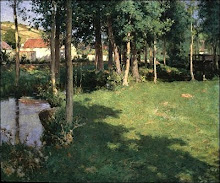Constant Troyon, A Clump of Trees, c.1860
George Inness, The Brook.
These works by Constant Troyon (top) and George Inness, make use of the golden light of dusk to suffuse the scenes with a sense of mystery. Warm golden hues - yellows sometimes with a touch of orange and red - are the perfect foil for dark grey-green foliage, creating a mood of soothing harmony.
The American landscape painter George Inness was so influential that he is often called "the father of American landscape painting".
In his mature period, Inness discovered the spiritual writings of the Swedish mystic, Emanuel Swedenborg. The late paintings are poetic and mystical, with landscape views that are more intimate and personal, and a handling of shapes that is more abstract and nebulous than the earlier, more descriptive paintings.
In a published interview, Inness maintained that "The true use of art is, first, to cultivate the artist's own spiritual nature." His abiding interest in spiritual and emotional considerations did not preclude Inness from undertaking a scientific study of color, nor a mathematical, structural approach to composition: "The poetic quality is not obtained by eschewing any truths of fact or of Nature...Poetry is the vision of reality."-Wikipedia
The glowing golden skies in these works would probably have been created by applying transparent glazes of a warm yellow over a white underpainting.

Geroge inness, The Monk, 1873.
Maple Screen, Hasegawa Tohaku.
It's possible that Inness was influenced by seeing the gold leaf backgrounds of Japanese folding screens (Byōbu), or it may have just been the symbolic association gold has with the Eternal.





.jpg)








.jpg)




+1900.bmp)
3 comments:
I was thinking of this very question this week when the students were examining the Heidelberg artists in Australia, largely in the 1885-1905 era. Collections of Heidelberg paintings are almost always titled Golden Summers, for appropriate reasons.
But how realistic are golden skies and how symbolic are they? I suppose it depends which country the artist is in, which season and which time of day. The gold leaf background of your Japanese example could not have been taken from life.. But could the top two paintings?
Or could the golden light of dusk be painted from life, then heightened for poetic effects.
Hi Hels.
Japanese screens seem to have been all the rage at the time.
Personally I have never seen a sky that was truly yellow; blazing orange/red, or silver, yes. But often what I love most in painting are the liberties that painters take with representation.
The giant eruption of Krakatoa in 1883 produced particularly brilliant sunsets, but unless there was gold dust in the volcanic plume...
I've read that, towards the end of his life, Inness mainly painted from memory, rather than in the field, so the poetic element would have predominated.
Not gold dust, but maybe yellow sulphur?
Post a Comment